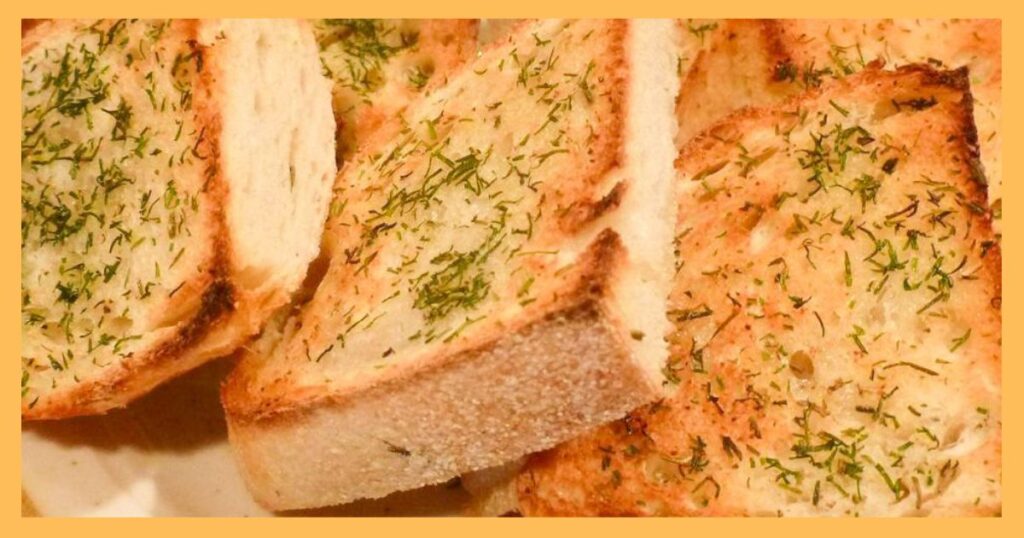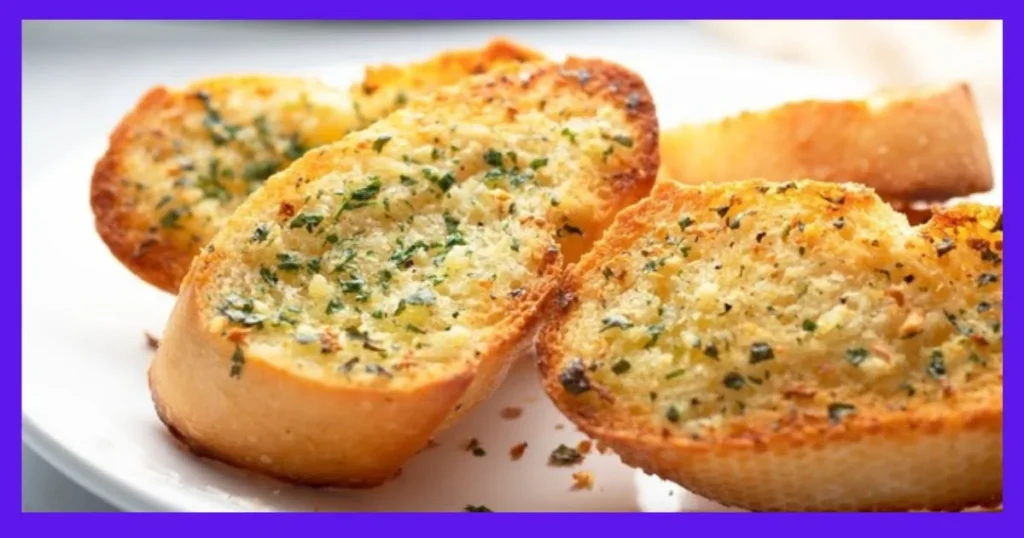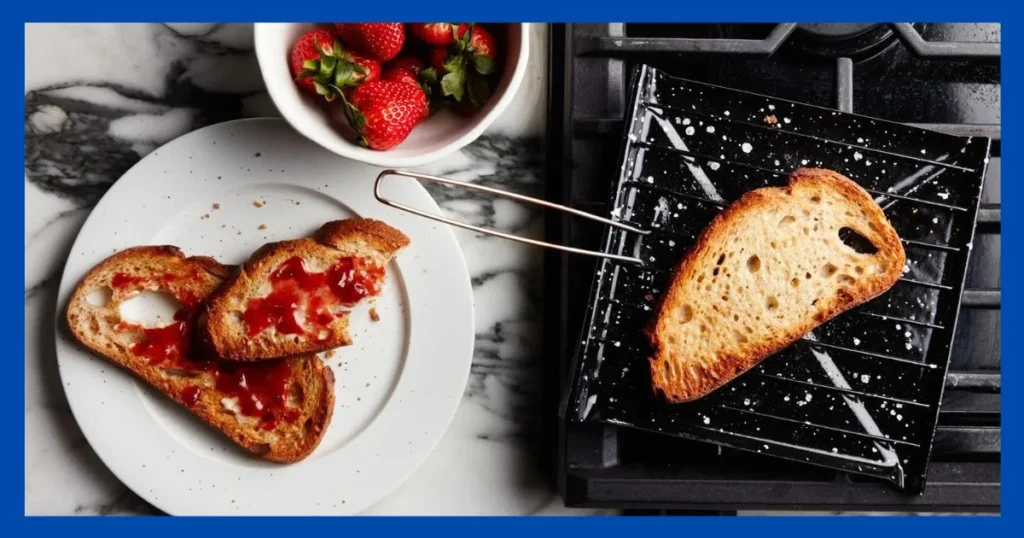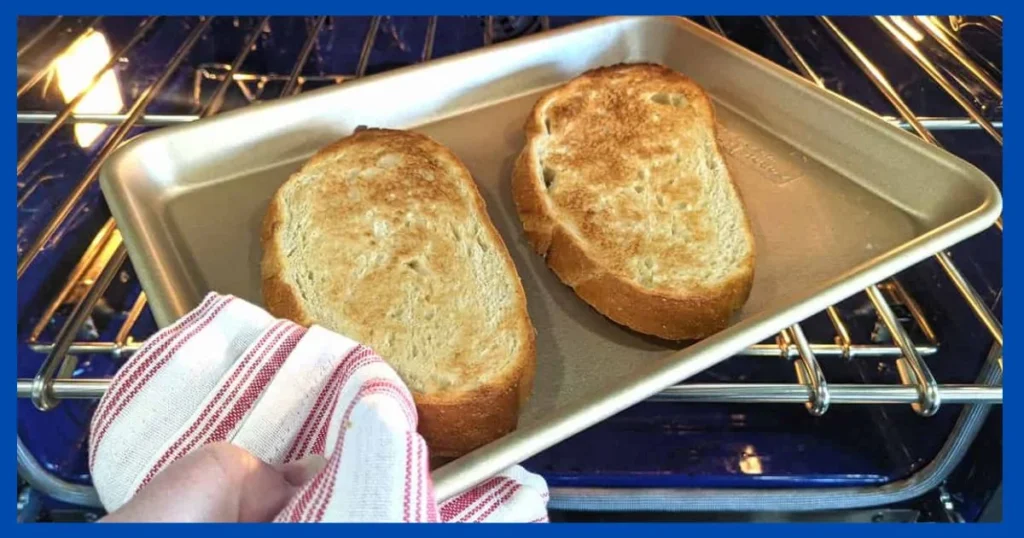Toasting bread in the oven with butter is easy! Simply preheat your oven to 400°F. Take a slice or slices of bread and spread butter evenly on one side. Place the bread butter-side up on a baking sheet. Bake for 5-10 minutes, until golden brown and crispy. The butter helps the bread toast up evenly and gives it a nice rich flavor.
What is the Best Way to Put Garlic Butter on Bread Before Baking?

Here are some tips for getting great garlic butter flavor into your bread before baking:
- Make a compound butter by mashing together softened butter with minced garlic, a little lemon juice, salt and pepper. Spread it evenly over slices of bread.
- Rub slices of bread with a halved garlic clove to infuse flavor, then spread with regular butter.
- Mix melted butter with minced garlic, brush it over bread slices, then sprinkle with parmesan cheese and dried parsley before baking.
- Make garlic bread sticks by cutting bread into strips, spreading garlic butter generously, and baking until crispy.
How Do You Make Cheesy Garlic Bread in the Oven?
Making cheesy garlic bread in the oven is simple! Start by mixing soft butter with minced garlic, parsley, salt, pepper and a dash of lemon juice. Slice a loaf of Italian or French bread in half lengthwise. Spread the garlic butter all over the cut sides of the bread. Top with shredded mozzarella, parmesan or your favorite cheese. Put the halves back together and wrap in foil. Bake at 400°F for 15-20 minutes until heated through and the cheese is melted. For an extra crispy top, unwrap for the last 5 minutes of baking. Serve warm from the oven!
What is the best cheese for garlic bread in the oven?
Here are some of the best cheeses for making garlic bread in the oven:
- Mozzarella – Melts beautifully into stretchy deliciousness. The most popular choice.
- Parmesan – Adds a sharp, salty flavor and crunchy texture on top.
- Provolone – Brings a creamy, smoky flavor.
- Asiago – A bolder, nutty cheese that holds its shape when melted.
- Fontina – Oozes into a gooey, rich garlic bread.
- Gruyère – Imparts a sweet, earthy Swiss flavor.
- Feta – Crumbles nicely over the top with salty, tangy notes.
- Cheddar or Gouda – Both become deliciously ooey-gooey and add color.
In general, semisoft, melty cheeses work best to thoroughly incorporate into the bread. Hard grating cheeses give a nice crunch on top. Go with your personal favorites!
How do you keep garlic bread from getting soggy in the oven?

Here are some tips to keep garlic bread crispy in the oven:
- Use firm, crusty bread like a baguette or ciabatta. Soft bread will get too soggy.
- Don’t overload the bread with butter. Just lightly spread enough to flavor it.
- Sprinkle some grated parmesan or mozzarella on top for a crispy finish.
- Bake the bread uncovered to allow moisture to evaporate in the oven.
- Cut the loaf into thinner slices rather than large chunks to reduce sogginess.
- Bake the bread on a rack on a baking sheet so air can circulate underneath.
- Finish under the broiler for 1-2 minutes to get a nice crispy crust.
- Let the garlic bread cool for a few minutes out of the oven before serving. This helps firm it up.
- Store any leftovers in a paper bag, not plastic, so moisture doesn’t get trapped.
What can I use instead of butter for garlic bread?
If you want to cut calories or fat, there are several alternatives to regular butter that still give great flavor to garlic bread:
- Olive oil – Has a nice richness and garlicky bite.
- Pesto sauce – Provides an herbal punch.
- Mayonnaise – Adds moisture and tang.
- Neufchâtel or goat cheese – Offer a creamy, spreadable texture.
- Ricotta cheese – Provides a lighter, milky base.
- Plain Greek yogurt – Has a nice thickness and tanginess.
- Hummus – Gives a smooth, hearty flavor.
- Mashed avocado – Provides creaminess and nutrition.
- Softened cream cheese – Mix with garlic for easy spreading.
- Light butter or olive oil spread – Keeps calories in check.
How long does garlic bread last in the refrigerator?
Freshly baked garlic bread will last 3-5 days when properly stored in the refrigerator. To maximize freshness:
- Let the bread cool completely before storing to prevent condensation.
- Place it in a sealed container or zip top bag. Make sure it’s covered tightly.
- Use within 2 days for the very best flavor.
- After 3-5 days, the bread may dry out slightly but is still fine to eat.
- Slice and toast to revive stale garlic bread.
- For longer storage, wrap tightly in plastic wrap, then foil, and freeze for 2-3 months.
- Leftover cooked garlic butter should be refrigerated and used within 1 week.
Keeping garlic bread refrigerated preserves the soft texture and guards against mold growth. Monitor for signs of hardening, moisture or green spots before eating refrigerated bread.
How to Toast Bread in the Oven

Toasting bread in the oven is a great hands-off way to prepare multiple slices evenly. The dry heat of the oven crisps and browns the bread for delicious results.
Benefits of Oven Toasting
- Toasts many slices of bread at once evenly.
- Frees up space on your countertop.
- Allows batch toasting ahead of time for things like breakfast or parties.
- Avoids the potential burned spots from a toaster.
- Can be used for specialty breads that don’t fit traditional toasters.
- Oven’s ambient heat dries out the interior as the exterior toasts.
Tips for Oven Toasting Success
- Use thick sliced bread – Thin slices can over-toast too quickly. Look for Texas toast or thick cut bread.
- Place bread in a single layer – Overcrowding slices causes steaming instead of crisping.
- Use a baking sheet – Lifts the bread away from any pooling moisture for crispness.
- Bake at 375-400 ̊F – High enough heat to toast before drying out.
- Flip once midway – Ensures even browning top and bottom.
- Check often – Ovens vary. Toast to your desired color in 2-5 minutes.
- Let cool briefly – Carries over cooking will continue slightly off the heat.
Oven Toasting Guide by Bread Type
| Bread Type | Oven Temp | Toasting Time | Notes |
|---|---|---|---|
| White sandwich bread | 400 ̊F | 2-3 minutes per side | Works for regular sliced bread |
| Wheat or multigrain | 375 ̊F | 3-5 minutes per side | Needs more time to crisp up |
| Sourdough | 400 ̊F | 3-4 minutes per side | Bake until crispy exterior |
| Bread sticks | 400 ̊F | 4-8 minutes total | Flip halfway through baking |
| Bagels | 375 ̊F | 4-6 minutes per side | Slice in half before toasting |
| Naan or pita | 400 ̊F | 3-5 minutes per side | May need longer for thicker breads |
| Croutons | 400 ̊F | 5-10 minutes total | Cube bread before baking until crispy |
| Baguettes | 375 ̊F | 3-5 minutes per side | Use sliced or whole with slit top |
What to Avoid for Oven Toasting
- Soft sandwich bread with a thin crust – Dries out too quickly.
- Batches that are too large – Will steam instead of crisp.
- Low oven temperatures under 375 ̊F – Takes too long to toast.
- Skipping flipping halfway through – Leads to uneven toasting.
- Over toasting – Results in a burnt flavor.
With the right technique, oven toasting can churn out perfect crisp slices of your favorite breads with little effort. Experiment to find what works best for your oven and tastes!
Toasting Bread in the Oven with Butter

Buttering bread before oven toasting gives you even browning and extra rich, savory flavor. The butter bastes the bread, keeping it moist on the interior while the exterior gets crisp.
Benefits of Oven Toasting with Butter
- Butter helps bread brown more evenly in the oven.
- Adds delicious flavor as the butter permeates the bread.
- Creates a softer interior crumb versus plain toasted bread.
- Butter acts as a protective coating to prevent drying out.
- Gives a satisfying crunch from the caramelized butter on top.
- Allows flavoring the butter with herbs, honey, garlic, etc.
How to Toast Bread in Oven with Butter
- Start with thick sliced bread – Thin bread won’t hold up as well. Brioche and challah work great.
- Soften butter – Let it sit out briefly until spreadable but not melted.
- Spread butter generously on one side – Use about 1/2 to 1 tablespoon per slice.
- You can add flavorings now – Honey, cinnamon, herbs, zest, etc.
- Place buttered side up on baking sheet – Space slices out evenly.
- Toast at 400 ̊F for 3-5 minutes – Flip and toast other side 2-3 minutes.
- Check frequently until golden brown – Keep an eye so it doesn’t burn.
- Let cool 1-2 minutes before serving – Butter will be hot!
Sprinkle with sea salt or cinnamon-sugar once out of the oven for even more flavor. Enjoy your butter-basted, bakery-quality oven-toasted bread!
Troubleshooting Oven Toasted Butter Bread
Bread is too dark on the bottom – Use a lower rack position so bottom doesn’t overcook before top browns.
Bread dries out during baking – Use thicker sliced bread and less time to prevent drying.
Butter burns or browns too quickly – Use lower oven temp like 375°F to slow butter browning.
Butter slides off during toasting – Make sure bread is room temperature before buttering so it adheres.
Not buttery enough flavor – Use more softened butter and spread it edge to edge.
Storing and Reheating Oven Toasted Butter Bread
- Let cool before storing so condensation doesn’t form.
- Place toasted buttered bread in a sealed container or bag.
- Refrigerate up to 4 days – freeze for longer storage.
- To reheat, place slices on a baking sheet at 300°F for 4-5 minutes.
- Microwave 10-20 seconds until warm – keep an eye to avoid sogginess.
Oven toasting with butter before storing gives you the chance to enjoy warm, restaurant-quality bread anytime. The cooled butter adds just the right amount of moisture.
Adding Garlic Butter to Oven Toasted Bread
Garlic butter slathered on bread before oven toasting infuses tons of garlicky goodness into every bite. Amp up the flavor even further by using garlic bread spices.
Benefits of Using Garlic Butter for Oven Toasting
- Imparts deep, aromatic garlic flavor into the bread.
- Butter acts as a great carrier for the garlic.
- Creates a savory crust from the browned butter and garlic.
- Softens and moistens the bread interior.
- Allows customizing intensity with more or less garlic.
- Convenient way to use up extra compound garlic butter.
How to Make Garlic Butter for Oven Toasted Bread
Ingredients:
- 1 stick softened butter
- 2-4 cloves minced garlic
- 1/2 teaspoon dried oregano
- 1/4 teaspoon dried basil
- 1/8 teaspoon pepper
- Pinch of salt
Instructions:
- Soften butter to room temperature to allow mixing.
- Finely mince garlic and combine with spices in a bowl.
- Add butter and mix thoroughly with spoon or fork.
- Taste and adjust seasonings as desired.
- Spread mixture evenly over bread slices before oven toasting.
Pro Tips:
- Let the minced garlic sit for 10-15 minutes to allow flavor to develop before adding to butter.
- Use a rasp grater for quick garlic mincing.
- Can make garlic butter up to 1 week ahead and refrigerate.
Any leftover garlic butter is fantastic spread on toast, grilled meats, or swirled into pasta. Make extra to have on hand!
What Bread to Use for Garlic Butter Oven Toasting?
Good bread choices for maximum garlic butter flavor:
- French baguettes – The archetypal garlic bread.
- Italian bread – Focaccia, ciabatta work well.
- Artisan loaves – Bâtards, boules nicely absorb butter.
- Sandwich bread – Look for wide slices to hold butter.
- Bread sticks – Spread butter before crisping.
- Pita or naan – Infuse Indian/Mediterranean dishes.
The best breads will have a sturdy yet porous crumb to soak up all that tasty garlic butter. Try different kinds to discover new garlic bread favorites.
Topping Garlic Bread with Cheese Before Baking

Ooey, gooey cheese on top of garlic bread straight from the oven is a match made in heaven. The cheese adds creamy richness to balance the garlic and herbs.
Benefits of Adding Cheese to Garlic Bread Before Baking
- Melted cheese gives luxurious, indulgent flavor.
- Helps brown and crisp the cheese topping.
- Bakes into deliciously melted strands and bubbles.
- Adds texture variations with shredded, sliced, or crumbled cheese.
- Moisture in the cheese keeps bread interior soft.
- Allows flexibility in type and amount of cheese.
- Visually appealing with melted cheese draping and browning.
How to Top Garlic Bread with Cheese Before Baking
- Spread sliced bread with softened garlic butter.
- Top with desired cheese – shredded, sliced or crumbled.
- Bake bread in preheated 400°F oven until cheese melts, about 3-5 minutes.
- Broil 1-2 minutes until cheese is browned and bubbling.
- Sprinkle on extra cheese, parsley, or red pepper flakes after baking for garnish.
- Allow to cool briefly before serving so cheese firms up slightly.
For even more decadence, layer two cheeses like mozzarella and parmesan or add sausage chunks under the cheese.
Best Cheeses for Garlic Bread Topping
- Mozzarella – Melts into perfect, gooey strands.
- Parmesan – Adds a sharp, salty crunch.
- Cheddar – Becomes wonderfully melted and bubbly.
- Provolone – Brings a creamy, smoky flavor.
- Asiago – A nutty, bold cheese that holds shape when baked.
- Feta – Salty, tangy crumbles.
- Fontina – Oozes into the bread divinely.
Play around with cheeses and amounts to create your own signature garlic bread masterpiece. Melty cheese completes this beloved appetizer.
Frequently Asked Questions
Here are some frequently asked questions given below:
What kind of bread is best for toasting in the oven?
Thick sliced breads with a sturdy crust work best, like Italian, French, or artisan breads. Good options include baguettes, boules, ciabatta, focaccia, bâtards. Avoid thin sliced sandwich bread which dries out too quickly.
What temperature should I use to toast bread in the oven?
350°F – 400°F is ideal. 400°F produces faster, more browned results. Lower temps like 350°F work better for larger breads. Adjust as needed based on your oven.
How long does it take to toast bread in the oven?
2-5 minutes per side depending on temperature and thickness of the bread. Thinner breads toast faster in 2-3 minutes while large boules take 4-5 minutes per side at lower temps. Watch closely to get the color you prefer.
Should I preheat the oven before toasting bread?
Yes, fully preheating the oven helps bread toast faster and more evenly. Put the bread in once it’s already hot. For thicker breads, you can turn off the oven halfway through toasting.
Is oven toasting healthier than using a toaster?
Oven toasting is considered healthier as the ambient heat dries out the bread more thoroughly so it retains less moisture. The lower heat also avoids potential burning or charring at high toaster settings.. What is the best way to store toasted bread from the oven?
Let the bread cool completely before storing to avoid condensation issues. Place toasted bread in a sealed bag or container at room temperature up to 3 days, in the fridge for 5 days, or freeze for longer storage.
What are some easy flavor variations for oven toasted bread?
- Cinnamon sugar toast – Spread butter on bread before sprinkling with cinnamon-sugar. Toast until caramelized.
- Everything bagel toast – Top buttered bread with everything bagel seasoning before toasting.
- Nutty honey toast – Brush bread with honey and sprinkle with chopped nuts before baking.
- Pesto cheese toast – Spread pesto sauce on bread before adding cheeses like mozzarella or parmesan.
- Caprese toast – Top garlic rubbed toast with tomatoes, fresh mozzarella, and basil.
- Apple pie toast – Top buttered cinnamon sugar toast with baked apple slices and caramel sauce.
- Breakfast toast – Schmear peanut butter and bananas on whole grain toast before baking.
The options are endless for customizing flavored oven toasts!
Can I toast bread directly on the oven rack instead of a pan?
It’s best to use a baking sheet or oven-safe pan rather than placing bread directly on the oven rack. This allows air flow all around the bread for even crisping. Direct rack contact can also create hard to clean spillovers.
How can I make oven toasted bread extra crispy?
- Use bread with a sturdy, chewy crumb and crusty exterior.
- Cut thicker slices instead of thin.
- Toast bread uncovered at a high temp like 400°F.
- Place bread directly on the baking pan instead of a rack.
- Flip halfway through to dry out both sides.
- Finish under the broiler for 1-2 minutes to crispen the surface.
Conclusion
Toasting bread in the oven yields deliciously crispy results with less effort than traditional toasters. It’s a great way to prepare multiple slices at once, free up counter space, and customize flavors like savory garlic bread or sweet cinnamon toast. Oven toasting brings out the texture and taste of artisan breads beautifully.
With the right techniques like moderate temperatures, flipping halfway, and avoiding overcrowding, you can achieve perfect crispness and color. Pay close attention the first few times as oven strengths vary. For enhanced flavor and moisture, spread bread with butter, garlic butter, pesto, or other topping before placing in the oven.
improvise the conclusion and make it sound unique using advanced language models and comprehensive summary of key points
Here is an improvised, comprehensive conclusion summary:
The sublime pleasures of oven-toasted bread beckon bakers to explore new culinary horizons. By harnessing the ambient heat of an oven, slices of bread can be elevated from the mundane to the artisanal. This versatile technique toasts bread more uniformly than counter-top appliances, freeing up space with maximized results.
From simple buttered bread to garlic-infused delights, the oven imbues each slice with nuanced aromatic notes impossible to attain through mere metal heating elements. By adjusting time, temperature, and positioning, the perfection of crunch and color can be achieved across diverse bread varieties. Observing the alchemical process closely is key, as ovens fluctuate in their heat distribution.
But the options for oven-toasted bread transcend the savory sphere. A dusting of cinnamon sugar transforms the bread into a sweet morning treat. Toppings of fresh fruit and streusel create a bakery-style pastry. Even drizzled glazes and sprinkled seeds can provide whimsical new experiences.
In summary, embracing oven-toasting unveils a breadth of flavors and textures hidden within humble loaves. With a dash of imagination and a willingness to experiment, anyone can become an artisan toaster. The oven’s steady heat promises satisfaction whether one seeks a crispy baguette or a caramelized brioche. A world of aromatic, golden-brown possibilities awaits those bold enough to venture beyond the confines of the standard toaster slot.
